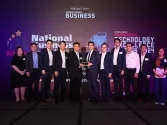
Phl power plant seeks 10-year PSA as supply deal nears end
Quezon Power Managing Director Frank Thiel confirms plans to extend the plant’s life and explore cleaner energy initiatives.
Coal-fired power plant Quezon Power’s 25-year power supply agreement (PSA) with the Philippines’ electric distribution company Manila Electric Co (Meralco) is set to expire by 2025. To keep the 460-megawatt plant running, Quezon Power is eyeing a partnership with a power retailer for a 10-year supply deal.
Frank Thiel, managing director of Quezon Power, sees this contract as a means to extend the life of the plant. Also, sufficient investment is vital to refurbish the power plant which has been in operation for over two decades now.
“The idea of a 10-year contract on the contractor side capacity-wise lines up perfectly with our ideal of having a longer-term fuel supply contract which gives us better prices,” Thiel told Asian Power in a recent interview.
Thiel, the general manager of the 455-megawatt San Buenaventura Power Limited, also confirmed the company’s plans to study ammonia co-firing to reduce Quezon Power’s carbon footprint. Here’s more on his responses during the interview.
Can you provide us with a brief overview of the Philippine electricity sector?
The Philippine energy sector is a very dynamic sector. I first came to the Philippines in 1992 when Manila was undergoing 10-hour shutdowns every day. Things have changed a lot. Over the years, different administrations have brought in more investment. There is a lot more power in the country but is there enough power? The answer is we probably could use more baseload capacity. I think at this point in time, it’s safe to say that additional power plants are needed.
The power demand is going up at around 4% per annum. We are seeing more buildings, more people, and more BPOs that increase the power demand. Now that LNG has landed in the country for the first time ever, we are hoping that there will be an opportunity to do more LNG-combined cycle plants that will provide the needed baseload capacity and will really help things along in the energy sector.
How have Quezon Power and San Buenaventura performed so far this year in terms of revenue and profit?
Both Quezon Power and SBPL have been performing rather well this year. We track some things that are very important to us: security, safety, and environmental impact. We have performed really well in all of those. Profit is important to the company, because you know, we are a business like any other business. But at the end of the day, what we focus on is reliability — making sure that we can deliver on our commitments to our customers; and making sure that the plants can deliver electricity at the lowest cost to consumers.
What are the challenges and risks faced by the two power plants this year?
Security or supply to our fuel. We buy all our coal in one single country, in this case, Indonesia. The Indonesian government from time to time has limitations for exporting coal. So that’s one of the risks that we always face. We keep a very large inventory of 45 days for QPL (Quezon Power Plant) and 30 days for SBPL (San Buenaventura Power Plant). That’s how we are able to mitigate the risk associated with fuel supply which is by far the biggest risk that a power plant like ours is facing here in the Philippines.
Aside from ensuring coal supply, what other initiatives are you implementing?
Well, we are constantly looking to see if we can increase or diversify the fuel supply by going to other countries. I have to say we are looking to try and bring coal from Australia, for instance, as an alternative that we are trying to evaluate at this point in time… that is something that we are focused on. Obviously, in the future, we want to become even more competitive than where we are right now. So we are evaluating different types of coal, coming from different jurisdictions.
What measures do you plan to take to ensure that the plant continues operations?
We are focusing on trying to see if we can get another long-term contract in particular with a retailer. That will be a 10-year power supply agreement. We are focused on how we are coming into that contract because we want to become very competitive and we want to offer ourselves as a really good company; somebody that can be trusted and can become quite reliable.
At the same time, we are looking at the plant proper. The plant has been operating for 23 years now and by the time the power supply agreement lapses, it will be 25 years; so we have to refurbish the plant. We are in the process of evaluating different parts of the plant to try and see how we can technically refurbish the plant and make it last longer, so that we can operate safely and reliably for another 10 years. We embarked on a technical evaluation of the power plant at the same time a commercial evaluation, trying to see if we can marry the two: On the one hand, by enhancing and refurbishing the plant; on the other hand, extending it by getting a different contract.
We try to sign for a longer term because if we are going to be making an investment to refurbish the plant, that’s a very sizable investment. The idea of a 10-year contract on the contractor side capacity-wise, lines up perfectly with our ideal of having a longer-term fuel supply contract which gives us better prices. Also, since we are making a significant investment in refurbishing the plant, we need time that will allow us to recoup that investment as well.
How is the targeted 10-year PSA different from your current PSA with Meralco?
The contracts will be similar but, at the same time, different. Similar in the sense that we do have an uptake, and basically contracting for the entire capacity of the plant. The terms will be different because things have changed a lot in the last 23 years. There’ll be perhaps a more balanced approach, and there’ll be a little more risk on us — a little more based on the retailer who’s going to be buying the contract capacity.
Having a long-term contract is similar to what we currently have, which gives us a projection of our revenue streams, and makes it easier for banks to get behind it if we were to finance it. There are 16 retailers in the country. We are approaching different retailers and we are hoping that one of them will be happy enough to sign with us. As we know, they have options and they have other generators approaching them. We have to make ourselves competitive, we have to be very good about what we do in order to entice a retailer to sign with us.
There are calls to shift to cleaner energy sources. How would this affect the operation of the two coal-fired power plants?
The company that we represent, the EGCO Group, has solar power, wind power, and fuel cells. Our company is very high on renewable energy already in different parts of the region. In the Philippines, Quezon Power is now looking at something quite interesting. It’s called ammonia co-firing. The idea is to try and reduce the consumption of coal by burning ammonia. Ammonia is a cleaner fuel, it doesn’t create any carbon dioxide when it burns.
We have engaged with an engineering company to support us with that. I’m quite optimistic that towards the end of the year, or next year, we may be able to try to co-fire ammonia in our boiler. In addition to that, we are looking constantly at the plant itself, trying to see if we can make it more efficient so that we can minimise the overall carbon footprint.
What other projects are in the pipeline for both plants?
We have the biomass co-firing and we also have the ammonia co-firing, which is up to 20%. We also have some projects in development and some years ago we started a wind development not very far from our facility. We have five years’ worth of wind data which is pretty solid and bankable, so we’re looking for an opportunity for that project to go forward.
At the same time, we are looking to see if we can participate in Meralco’s competitive selection process. If that were to be successful, then we would have three units in our hands. This time around, it’s not going to be coal because of the Department of Energy’s moratorium on coal-fired plants. We are very keen to develop an LNG combined-cycle plant. We do have land available for now and a transmission capacity for that. We also have a lot of support from the local community. We are very familiar with combined-cycle plants because we have several of them in the company. We are hoping to simply have an opportunity and be competitive, and we’ll have a third unit on the construction before too long.








![Cross Domain [Manu + SBR + ABF + ABR + FMCG + HBR + ]](https://cmg-qa.s3.ap-southeast-1.amazonaws.com/s3fs-public/styles/exclusive_featured_article/public/2025-01/earth-3537401_1920_4.jpg.webp?itok=WaRpTJwE)
![Cross Domain [SBR + ABR]](https://cmg-qa.s3.ap-southeast-1.amazonaws.com/s3fs-public/styles/exclusive_featured_article/public/2025-01/pexels-jahoo-867092-2_1.jpg.webp?itok=o7MUL1oO)









 Advertise
Advertise


